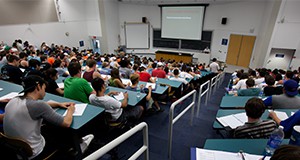At some point, most people are faced with the daunting task of delivering a presentation. These presentations could be required by job responsibilities, as an academic assignment, or in roles within the community. Presentations may be delivered to small or large audiences. Giving a presentation in front of an audience may be a frightening endeavor; however, this new 4-page publication of the UF/IFAS Department of Agricultural Education and Communication provides five steps to make the task of giving a presentation easier and ensure that your presentation will be effective. Written by Brianna Shanholtzer, Andrew C. Thoron, and J. C. Bunch.
https://edis.ifas.ufl.edu/wc337
Tag: J. C. Bunch
Using Interest Approaches in Instructional Design and Delivery
Most educators know that it can be challenging to get students motivated to learn at the start of a lesson. The importance of student motivation, academic desire, and engagement is well noted as these factors have been directly linked to students’ academic achievement. An interest approach uses a brief activity to stimulate students’ situational interest toward a topic. Although situational interest is typically held by the learner for a short duration, establishing situational interest at the start of the lesson maximizes students’ engagement, motivation, and attentiveness toward the lesson’s topic and student learning objectives. This new 4-page publication of the UF/IFAS Department of Agricultural Education and Communication describes components of interest approaches and techniques for integrating them into a lesson, and provides real-world examples. Written by Brianna N. Shanholtzer, Andrew C. Thoron, J. C. Bunch, and Blake C. Colclasure.
http://edis.ifas.ufl.edu/wc334
What is Understanding by Design (UbD)?
This 5-page document discusses Understanding by Design, an approach to designing curriculum that allows instructors to focus on desired learning outcomes and provide structure for student learning. Written by Tyler L. D’Angelo, Andrew C. Thoron, and J. C. Bunch and published by the UF/IFAS Department of Agricultural Education and Communication, January 2019.
http://edis.ifas.ufl.edu/wc322
Teaching for Extrinsic Motivation

Motivation is the idea of being moved to do something, and levels of motivation vary among every individual. Extrinsic motivation is a specific type of motivation that is fueled by external rewards or an expected outcome. This 2-page document, written by Isabella Damiani, Andrew Thoron, and J. C. Bunch and published by the UF/IFAS Department of Agricultural Education and Communication, discusses how educators can foster extrinsic motivation among their students.
http://edis.ifas.ufl.edu/wc307
Selecting Educational Resources
Many instructors struggle to find appropriate educational resources. However, collaborative teaching and learning efforts have created a number of educational resources that can be stored, shared, adapted, and used within the agricultural education profession. This 7-page document will help educators in selecting educational resources. Written by Tyler D’Angelo, Deb Barry, J. C. Bunch, and Andrew Thoron and published by the UF/IFAS Department of Agricultural Education and Communication, June 2018.
http://edis.ifas.ufl.edu/wc303
Teaching and Learning: Motivating Learners
Motivation is a process that drives individuals forward. Educators must be aware of the continuum of motivation and appropriately provide opportunities for student engagement, learning, and growth. This 2-page document discusses how to motivate learners. Written by Isabella Damiani, Andrew Thoron, and J. C. Bunch and published by the UF/IFAS Department of Agricultural Education and Communication, May 2018.
http://edis.ifas.ufl.edu/wc305
Utilizing Demonstrations in Teaching, with An Example Demonstration of Plant Propagation via Cuttings
In a learning environment, it is important to provide instruction to each type of learner. This 4-page document discusses utilizing demonstrations for different types of learners and includes a sample demonstration of plant propagation. Written by Isabella Damiani, Andrew Thoron, and J. C. Bunch and published by the UF/IFAS Department of Agricultural Education and Communication, May 2018.
http://edis.ifas.ufl.edu/wc306
Instructional Design Using the Dick and Carey Systems Approach
Instructional design is a system of procedures used for developing instruction and training curricula in a consistent and reliable method. This 5-page publication applies the best practices of instructional design using the Dick and Carey systems approach. Written by Tyler D’Angelo, J. C. Bunch, and Andrew Thoron and published by the UF/IFAS Department of Agricultural Education and Communication, March 2018.
http://edis.ifas.ufl.edu/wc294





